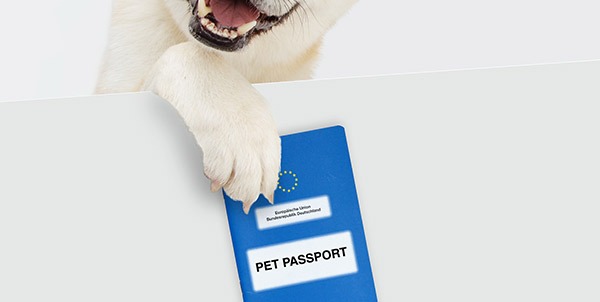Table of Contents
PET PASSPORT, THE EUROPEAN PET PASSPORT
If your travel destination is outside Italy, be aware that a Pet Passport, or European Pet Passport, must be applied for when traveling within European Union countries for dogs, cats and ferrets.
Travel of companion animals from one state to another is now widespread and frequent.
Thus the need arose to enact legislation to regularize such moves.
Laws aimed at defending and protecting not only animal health, but also human health.
The main objective of preventive health protocols is to prevent animals from contracting and spreading epidemiological diseases, with particular reference to rabies.
THE REGULATIONS FOR ANIMAL TRAVEL
As far back as 1969, the Ministerial Decree the“Sanitary Regulations for the Importation and Transit of Animals Accompanied by Travelers,” stipulated that dogs and cats accompanying travelers must have a certificate of origin and health issued by a veterinarian officially authorized by the state of origin.
This document was also used as a valid certificate for expatriation.
On October 1, 2004, the Regulation no. 998/2003.
This legislation regulated the animal health conditions to be applied to the non-commercial movement of pet animals between EU member states and from third countries.
A “passport” was introduced, that is, a document containing all the information needed to clearly identify the pet and ascertain its status.
FINALLY, THE CURRENT REGULATION NO. 576/2013
In 2013, the new EU Regulation no. 576/2013 repeals the previous one and defines in more detail:
- The rules that apply to non-commercial movements and trade and imports into the Union from third countries of dogs, cats and ferrets.
- legal framework for animal health conditions applicable to non-commercial movements of species not affected by rabies or without epidemiological significance to which, if they were not kept as pets, other legal acts of the Union would apply, including legislation on food-producing animals.
The regulation contains an annex divided into two parts that specifies what pets are:
- Part A includes dogs, cats and ferrets.
- Part B, on the other hand, includes amphibians, reptiles, birds, small mammals not intended for food production (including rodents and rabbits) and invertebrates (excluding bees, mollusks and the crustaceans).
THE PET PASSPORT AND RABIES PROPHYLAXIS
Rabies is a lethal disease that affects the central nervous system of mammals, both wild and domestic: foxes, badgers, martens, dogs, cats, ferrets, cattle and horses.
It is a zoonotic disease (or zoonosis) in that it can be transmitted from the ‘infected animal to humans as well.
Italy had gained recognition as a rabies-free state in 1997.
Years later, unfortunately, the disease reappeared in the northeast of the country following the spread of an epidemic that had developed in neighboring eastern countries.
In 2008 the rabies affected Friuli Venezia Giulia (provinces of Udine, Pordenone, and Trieste), and in 2009 also Veneto (province of Belluno) and the Autonomous Province of Trento.
Vectors of the disease, in these cases, were infected foxes.
RABIES PROPHYLAXIS
Rabies vaccination should be given NO LATER than 12 weeks of the animal’s life.
It is considered valid 21 days after the first inoculation and from the date of new vaccination if it is a booster of the previous vaccine.
Precisely because rabies vaccination must be carried out at least 21 days prior to the animal’s introduction into the country of destination, we recommend that you apply for a Pet Passport at least 1 month in advance of your planned departure date.
In the event that the rabies vaccination was given before the European Pet Passport was issued, it can also be transcribed after it was issued but always by the Veterinarian who carried it out.
The Pet Passport does not have a validity date-it is the vaccinations and treatments listed therein that have an expiration date.
THE INFORMATION CONTAINED IN THE PET PASSPORT
The European Pet Passport is issued by the veterinary services of the Local Health Authority at the request of the owner.
For the Pet Passport to be issued, the animal must be registered with the pet registry and identified by microchip or tattoo (only if applied before July 3, 2011, and if perfectly legible).
If you have not already done so, see your local veterinarian to microchip your dog.
The contents of the Pet Passport:
- The European Pet Passport consists of a cover bearing the symbol of the European Union, followed by the words “pet passport”
- At the bottom is the ISO (International Standard Organization) number of the country where the document was issued
- Contains a biographical section and a health section with rabies vaccination details, any clinical examinations, therapeutic treatments
- Species, breed, sex, date of birth of the animal.
- Number of microchips
- Name and contact information of the owner or person authorized to hold it
- Name, contact information and signature of the official or authorized veterinarian issuing the identification document
- Details of rabies vaccination
- Date of blood sample collection for rabies antibody titration test
- List of all vaccinations given, including rabies vaccination
- Compliance with preventive health measures for diseases or infections other than rabies
- Medical examinations
- Any treatments againstechinococcus multilocularis as required by EU Delegated Regulation 1152/2011 in the case of travel to Finland, the United Kingdom, Ireland, Malta and Norway.
OTHER PET PASSPORT SPECIFICATIONS
However, since December 29, 2014, a change has been made: this threshold can be exceeded if the purpose of the trip is participation in contests, exhibitions or sports competitions.
The owner must have a written certificate attesting to participation in such events, and the animals must be at least 6 months old.
WHEN IN ROME, DO AS THE HEALTH STANDARDS DO
When the destination of the trip is a third country, i.e., not part of the European Union, special health requirements and additional documents may be required than for EU countries.
Since sanitary conditions may vary depending on the destination, it is advisable to find the necessary information by contacting the third country’s embassy in Italy, or directly contacting the veterinary service of the relevant local health authority for the possible issuance of the necessary health certification.
Some third countries (UAE, Australia, Canada, Japan, the United States, South Africa) have very strict laws in place that may provide, for example, quarantine periods and, therefore, separation of the animal from its owner even for long periods. Therefore, it will be useful for you to acquire the information even five or six months in advance.
Microchipping, preventive examinations and vaccine prophylaxis are just some of the services that La Veterinaria Clinic can offer you.
We would also like to remind you that Clinica La Veterinaria is always open, every day h24 including holidays and with First Aid service from 8 pm to 8 am.
For the joy of seeing them happy.











